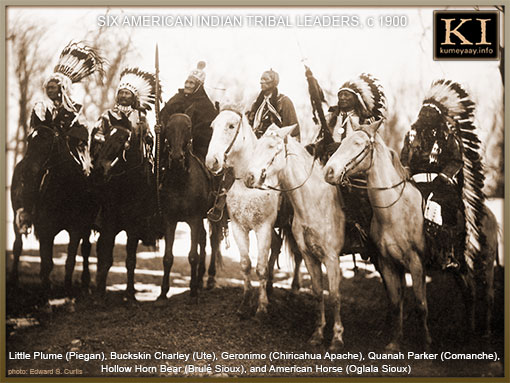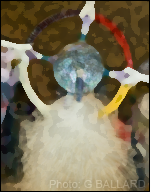TOP 10 GREATEST INDIAN CHIEFS
California Indian Education's tribal resource is being compiled to introduce young Native American Indian students to a few of their nations' most famous Indian chiefs of North America, brave tribal leaders and warriors who have left their mark on the recorded history of our great lands — please do your own research to learn more in-depth facts, tribal biographies and their most noteworthy quotes about these famous Native American Indians.
The California Indian Education website's "Top Ten" Indian chiefs is not so much about listing the top 10 chiefs of all time (which will forever be debatable), but our Indian guide is about beginning a study resource to familiarize students with some of the most important and influential Native American leaders of the recorded history.
FAMOUS INDIAN CHIEFS LEADERS WARRIORS QUOTATIONS SPEECHES
| INDIAN CHIEFS, WARRIORS, LEADERS | ||||
 Geronimo GeronimoApache 1829-1909 |  Chief Joseph Nez Percé 1840-1904 |  Benito Juarez Zapoteca 1806-1872 |  Cinon Mataweer Cinon MataweerKumeyaay 1800s | |
 Tecumseh Shawnee 1768-1813 |  Adam Castillo Adam CastilloCahuilla 1885–1953 |  Chief Hatam Kumeyaay c. 1805-1874 |  Charles Curtis Kaw 1860-1936 | |
 Captain Jack Modoc 1837-1873 |  Crazy Horse Lakota c. 1845-1877 |  Russell Means Russell MeansOglala Lakota 1939-2012 |  American Horse American HorseSioux c. 1800-1876 | |
 Anna Prieto-Sandoval Kumeyaay 1934-2010 |  Chief Dan George Tsleil-Waututh 1899-1981 |  Richard Milanovich Cahuilla 1942-2012 |  Mangas Coloradas Mangas ColoradasApache c. 1793-1863 | |
 Black Hoof Shawnee c. 1740-1831 |  Cochise Apache 1812-1874 |  Red Jacket Red JacketSeneca c. 1750-1830 |  Chief Seattle Duwamish c. 1780-1866 | |
 Shacknasty Jim Shacknasty JimModoc c. 1851–1881 |  Red Cloud Red CloudLakota 1822–1909 |  Standing Bear Standing BearPonca c. 1834-1908 |  Sitting Bull Lakota c. 1831-1890 | |
 Chief Pontiac Chief PontiacOttawa 1720-1769 |  Osceola OsceolaSeminole 1804-1838 |  Wilma Mankiller Wilma MankillerCherokee 1945-2010 |  Chief Manuelito Navajo 1818-1893 | |
TRADITIONAL American Indian Quotations
| ||||
FAMOUS NATIVE AMERICAN CHIEFS ON HORSES WEARING CEREMONIAL FEATHERED WAR BONNETS HOLDING TRIBAL STAFFS

SIX 19TH CENTURY NATIVE AMERICAN LEADERS ON HORSEBACK (l-r) — Little Plume (Piegan), Buckskin Charley (Ute), Geronimo (Chiricahua Apache), Quanah Parker (Comanche), Hollow Horn Bear (Brulé Sioux), and American Horse (Oglala Sioux). Photo: Edward S. Curtis, circa 1900.
AMERICAN TRIBAL SOVEREIGNTY — LEGAL BASIS: The Constitution of the United States, U.S. Supreme Court, federal and state laws, as well as historical treaties all support the federally-recognized Native American tribes' present-day legal rights to self-government and certain forms of limited tribal sovereignty....


No comments:
Post a Comment